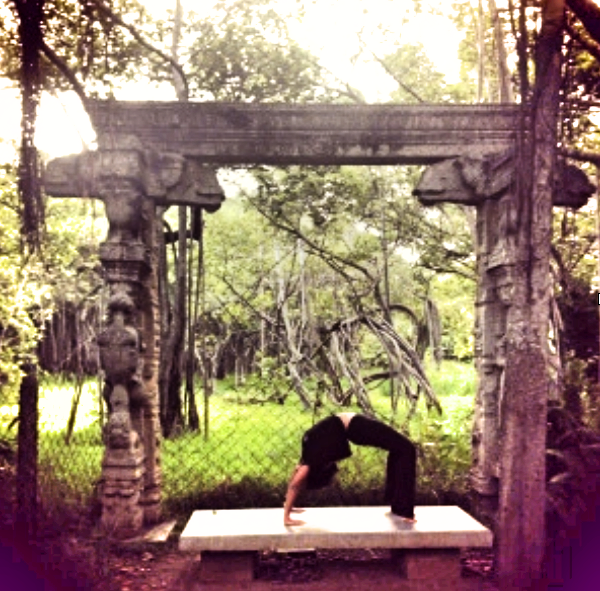“Re-Embodying”, by Priya Krishnan
March 29, 2016
“You only have to let the soft animal of your body love what it loves.” –Mary Oliver
The following is a guest blog post by Priya Krishnan for the Yoga and Body Image Coalition. Featured photo taken beneath the 450-year-old Adyar Banyan Tree at Chennai’s Theosophical Society.
In the months following college graduation, stepping out into the “real world,” I have found myself returning again and again to the central axis of my yoga mat seeking grounding. Although I was raised in the rich traditions of Hindu philosophy, I first came to the asana realm of yoga practice in college because I craved a greater somatic awareness. Years of subscribing to media conceptions and bowing under the stress of taking on more responsibilities than I could handle had led me to become, quite literally, disembodied.
The first yoga I remember doing that felt authentic was in the safety of my dorm room. In classes, teachers would give me cues such as, “Stand with your feet hip width apart” or “Internally rotate your legs.” I had worked so actively to cultivate a poisonous attitude of self-hate towards my body that I lacked the spatial awareness to comprehend these cues and eschewed these classes. I am not sure if most people would recognize what I did in my dorm room as yoga. It involved a lot of lying on my mat in child’s pose in the early mornings or before bed, trying to bring some semblance of calm to a life that I felt was completely out of control. I didn’t know what hip width apart was, but my mat felt like a safe, private place where I could start to reorient myself.
I bounced around different styles of yoga for a while, but I didn’t feel truly comfortable at any of the classes I attended, partially because I felt that my body type deviated from that of the “ideal yogi” and because I was tired of being the only Indian student in a class where a teacher would say things like “Namaste, b****es,” flinging around sacred words without heed for their roots. For a while, I was part of a fitness organization that branded the word ‘Om’ on the butt area of their leggings, and when I voiced my concerns, I was told that I had no right to complain and that yoga didn’t belong to me.
Although I don’t think yoga belongs to anyone (in fact, I believe strongly that it should be accessible to everyone), it was hard for me not to feel that some studios I visited wanted to appropriate or incorporate Hindu culture much more than they wanted to include actual Indian people in their classes. In one class, where a teacher struggled to croon incoherent Sanskrit chants and told us to “Put a little bass in our chakras,” I was told to move to the back of the room because “my body probably couldn’t do the poses” that the instructor wanted to teach. I found solace in a college seminar on the “Philosophy and Practice of Yoga” taught by Dr. Sue Dwyer, who was both authentic and inquisitive. As a final project for that seminar, I explored the intersections of yoga and feminism. I also discovered the Yoga and Body Image Coalition, of which I am now privileged to be a community partner.
After college, taking a year off before pursuing medical studies, I moved to Boulder, Colorado, beckoned by the call of the mountains. Boulder has the highest number of yoga studios per capita in the U.S. In the Hindu religious tradition, there is a prominent idea of the guru-shishya parampara, an unbroken sacred lineage through which knowledge is transmitted from teacher to student. Ashtanga vinyasa yoga is a branch of yoga rooted in parampara. The sequence of poses was largely developed by Sri T. Krishnamacharya and his student Sri K. Pattabhi Jois (often referred to as Guruji). Guruji taught many students in the West, including Richard Freeman and Mary Taylor, founders of the Yoga Workshop in Boulder in 1987.
I had first heard of Ashtanga vinyasa while browsing free yoga classes on YouTube, and through trying little instructional snippets from Kino MacGregor. I was eager to try a class, as I felt that it was a setting that would encourage me to maintain cultural integrity while beginning a regular asana practice. Tentatively, I signed up for an Intro to Mysore workshop with Ty Landrum, the current director of Yoga Workshop. I was immediately struck by the physicality of the practice and how I was able to feel both empowered and humbled, even if I wasn’t giving a “perfect” expression to a particular asana. And I knew that I wanted to keep practicing because I felt an inner spark to learn more. Through the Yogis Heart Scholarship, I have been blessed to receive a year of unlimited study at Yoga Workshop.
Mysore practice itself, which is at the heart of Ashtanga, involves practicing individual asanas in sequence within a group setting as the teacher walks around the room and gives personalized directions to each student where they may need it. My first few Mysore classes seemed at once disorienting and meditative, indulgent and austere. I found (and still sometimes find) my eyes wandering to other practitioners folded into impossible shapes. But in Mysore there are no music or mirrors. There is only the truth of your body carried moment to moment by the breath.
In the few months that I have been practicing Mysore (4-5 times a week), and especially throughout the trying process of medical school applications, it has become my touchstone. I don’t believe there is any style of yoga that is better than others, but I do believe each person can find a style that resonates with them most fully. For me, Ashtanga vinyasa has gifted me the medium to come back into my body slowly and unapologetically. It is a truly radical thing to be able to feel the beginnings of my shoulder externally rotating or my thighs drawing upward. At the same time, falling out of poses or struggling to maintain balance reminds me not to take myself too seriously. Making peace with my body is helping me to be in harmony with the way my life progresses. I am thankful to have discovered a practice through which I am reminded daily to return to the truth of each moment using the compass of my body and breath.
 About Priya:
About Priya:
